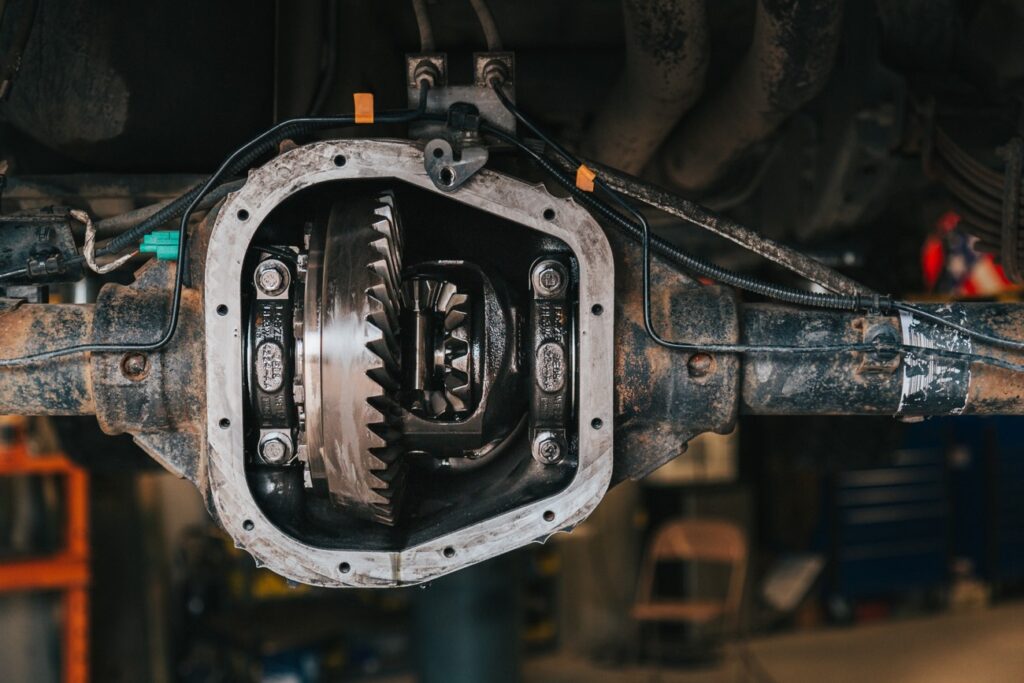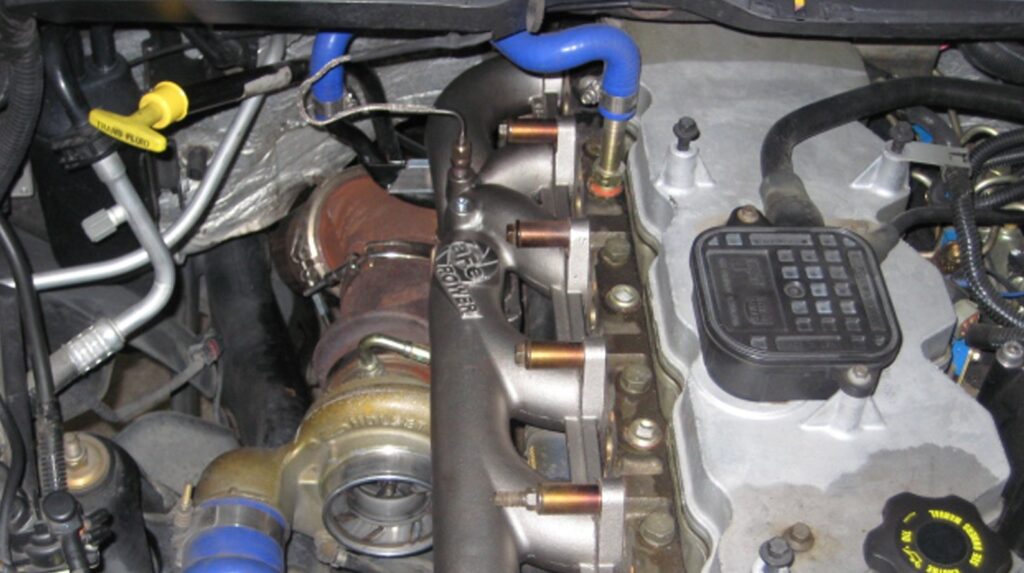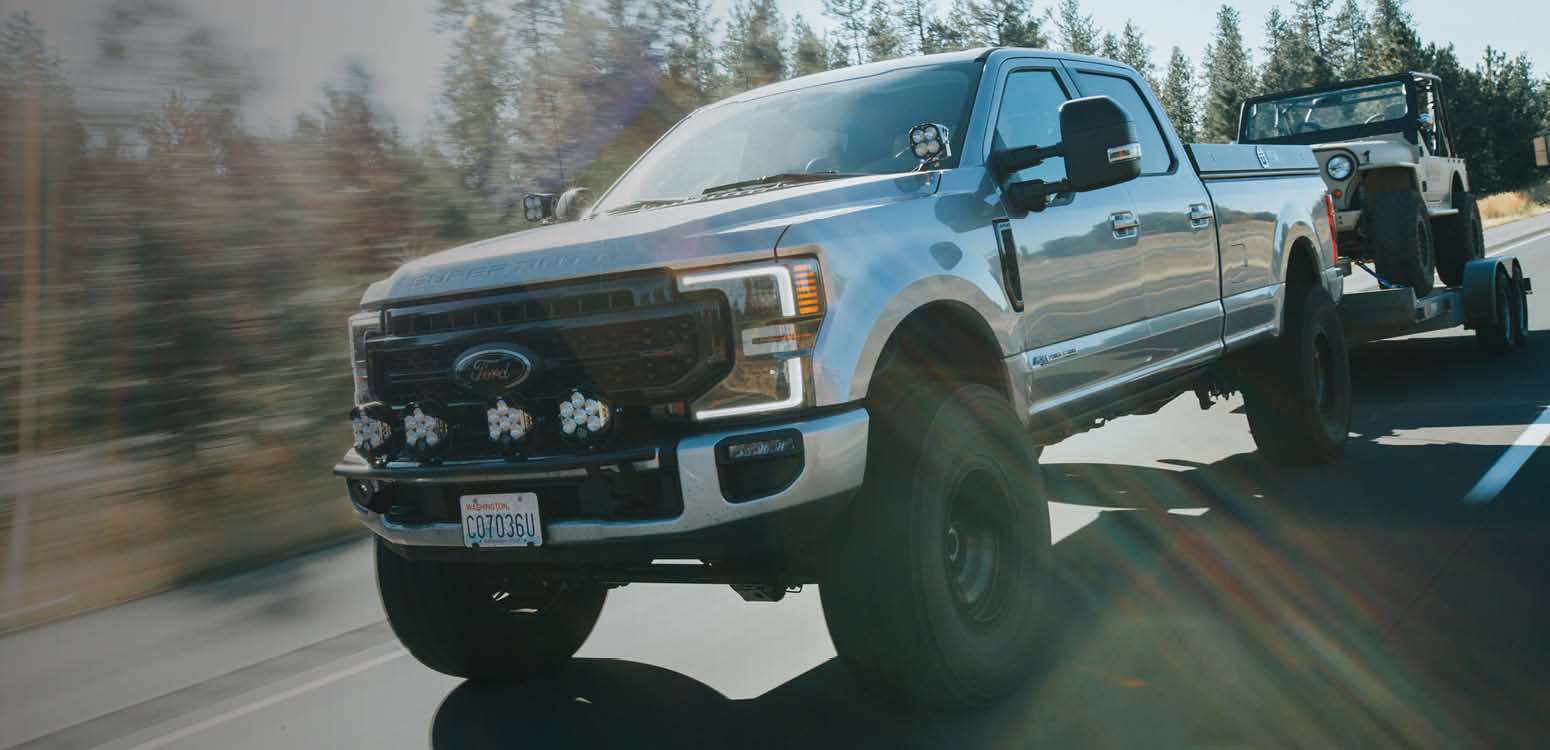Half ton gasser pickups can tow an impressive amount and still have a manageable size for daily driving, and they have a chassis that rides incredibly smooth as well. Most ½ tons are rated to tow a trailer in the ballpark of 9,000lbs which will easily handle a 20-something foot open trailer with another ½ ton truck parked on the back. A pair of side by sides is also no problem if you have a trailer long enough, but if you need to haul a small skid-steer, mini-excavator, a six-horse trailer, or a dump box filled with concrete, a ½ ton is out of the question. Depending on how the truck is equipped, most 3/4 and 1-ton diesels can tow at least twice what a 1/2 ton will, but if you spec’d a long box dually, those numbers can be pushed well into the 30,000-pound range, which is staggering for a pickup, but drivers are always reaching for more capability and a better towing experience.
Today, we’re talking about parts that help your truck tow better, but let’s make one thing perfectly clear right away: you cannot legally haul anything that exceeds the weight rating on your truck’s door tag. The manufacturer of your truck has rated it to safely carry a certain weight, and you are flirting with disaster if you try to tow or haul more than that. Also, each truck is built differently, and just because your buddy’s crew-cab Cummins has a GTWR of 24,000lbs doesn’t mean yours will have the same. Seemingly insignificant differences in the truck like 2wd vs 4wd, short vs long bed, and even the gear ratio can make an impact on the weight rating, and you’re stuck what’s printed on the door sticker. That being said, there are some modifications and upgrades you can do which will make the truck more comfortable and capable when hauling at its maximum rating. Today, we’re going to focus on things that will help the truck run cooler, stop safer, keep the chassis stable, and even help accelerate a heavy load a little easier, and believe it or not, even use a little less fuel.
The Right Gear
“Give me a lever long enough, and I’ll move the world.” Apparently, some old Greek math nerd is credited with saying something to that effect, and as odd as it sounds, the principles of leverage are being used in your truck to help it move. Gears in the transmission, transfer case, and differential change the drive ratio between the engine and the tire to effectively give the engine more leverage. The ratios are optimized to provide a good balance between acceleration and highway speed, but any time you modify your truck from its factory configuration, you can alter its towing performance for the worse. For example, one of the most common upgrades made to a diesel truck is a taller off- road tire. These days, 37- or 40-inch tires are commonplace and thankfully tire manufacturers do offer “E” and “F” load ratings in those larger sizes to safely handle the weight, but before you head down to the tire shop, you need to understand how a larger diameter tire will affect your trucks towing performance.
Let’s say your truck came equipped with a 33-inch-tall stock tire and you step up to a 40-inch-tall mud terrain: that’s a 21% increase in diameter, but more importantly the larger tire will effectively reduce your available torque by the same amount. Taller tires are harder for the engine to turn, and that’s not counting the added weight or resistance of an aggressive tread. While driving unloaded, these effects might not seem that noticeable, but as soon as you attach a trailer, you will notice a clear loss of acceleration. To restore balance, you need to change gearing in the front and rear axle to compensate for the larger tires. A good rule of thumb is to match the percent change in tire diameter to gear ratio, so if you have 21% larger tires and 3.73s, your new ideal ratio would be 4.51:1. While that exact gear ratio isn’t produced, the closest options are 4.30:1 or 4.56:1 and some time with an online RPM and MPH calculator will help make your decision. One thing to remember though: numerically higher gears will give better acceleration, but the tradeoff is a higher RPM on the highway. It’s also worth noting that the factory doesn’t always install the ideal ratio. On a Ram 3500 for example, depending on which options you choose, it may come equipped with 3.42, 3.73, or even 4.10 gears. While a 3.42 will deliver the best fuel mileage of the bunch, when towing, the 4.10 will offer a distinct advantage.
Re-gearing sounds simple enough, but in reality, it’s an extensive process usually best left to the professionals, but when sourcing parts, Yukon Gear & Axle has everything you need to re-gear and re-build your differentials. They offer gearsets in a wide range of ratios, bearing kits, and limited slip or locking differentials to make sure you have traction from both rear wheels, which is especially helpful when towing off road.
One lesser-known trade-off of a lower gear like 4.56 or 5.13 is they generally run at a higher temperature, but whether you’re re-gearing or not, it’s always a good idea to protect your axles and keep them running at a cooler temperature. When towing a steep grade with a heavy trailer, your gear oil temperature can reach well over 300 degrees Fahrenheit with the stock differential cover in place, but the Banks Ram Air cover has been designed to remove excess heat. It has a patented scoop that draws air across the back of the cover, and its internal design lets the fluid circulate efficiently inside the axle. This will help drop the temperature of your differential substantially, and when combined with a quality synthetic lubricant from Schaeffer’s, you’ll have a cooler running and longer lasting differential that will also lead to a slight increase in fuel mileage.

Stopping is Important
Being able to take off is great, but stopping your truck and trailer is much more important, especially if you tow in the mountains of the western United States. Your truck will have heavy-duty brakes from the factory that can stop a load once or twice by themselves, but if you are relying on your truck’s service brakes alone, they will rapidly heat up and eventually overheat to the point they no longer work. Thankfully, most trailers over a few thousand pounds are equipped with built-in electric brakes, but your tow vehicle needs a way to actuate them. Newer rigs can come optioned with trailer brake controllers, but if your truck was made more than 10-15 years ago, you will need to add an aftermarket controller to actuate the trailer’s brakes. The Tekonsha P3 will integrate into your trucks wiring harness so it knows when you step on the brake pedal, and it will send the needed high current power along to the trailer’s brakes. The P3 will control brakes on up to four axles and will actuate electric or even electric over hydraulic systems, which means it’ll work with just about any trailer you hitch up to.
Even when using your truck and trailer brakes in tandem, you can still overheat your braking system on a long down-grade, but there is another way to slow your truck without using the brake pedal at all, and that’s with an exhaust brake. Once again, most modern diesels will have this capability built-in from the factory, and it works by fully closing the vanes inside the variable geometry turbo when the throttle is released, which creates backpressure in the exhaust, and when combined with a downshift and a locked torque converter, you get a ton of braking power from the engine. This operation is seamlessly controlled by the ECM, and even though it’s only been available as a factory option for about 10 years, older trucks with a variable geometry turbocharger like the LLY, LBZ, or LMM Duramax as well as the 6.0 Powerstroke can be tuned to have the same functionality with a performance calibration from DuramaxTuner.com. When switched to the towing setting and the throttle is released, the exhaust vanes close, the torque converter will stay locked, and in total you get an additional 120 braking horsepower available to slow your truck and save your brakes.
If your truck has a fixed-vane charger, you can still have the benefits of an exhaust brake without needing to install a VGT. Pacbrake, BD Diesel, and Banks all offer exhaust brake kits that install a butterfly valve in the exhaust system, which is operated by an air cylinder. The control system is integrated into your trucks wiring to gather signals from your accelerator and brake pedal, and when the valve closes, your braking power goes up dramatically. Some would argue that the stopping performance is even better than a closed vane pack on a turbo, and you can even add a butterfly style exhaust brake to a truck that has a variable geometry turbo.
Temperature Monitoring
Every truck has a coolant temperature gauge to let you know if the engine is overheating or not, but the water inside the engine is much too slow to react to the rapidly changing conditions seen inside your engine while towing, so coolant temp isn’t the most helpful parameter to keep an eye on. Instead, the exhaust gas temperature (EGT) is the number one variable which needs to be monitored on a diesel truck, especially when towing a heavy load.
No diesel pickup I know of has a factory EGT gauge for the driver to view, but some trucks at least have built-in exhaust temperature sensors. It is worth nothing that most trucks made in the last five years will have some form of EGT control as well, that will defuel slightly to reduce power and keep temps under a certain threshold, usually around 1,500F. On an older truck there is no built-in safety net, so it’s up to the driver to keep temps in a safe zone, and the easiest way to do that is to install a pyrometer which taps into the exhaust manifold, and a gauge mounted inside the cab to tell you instantly how hot your diesel is running. If you prefer an analog gauge, you can buy a Factory Match style from Autometer which will look exactly like your instrument cluster, or if you prefer the high-tech look, an Edge CTS3 or a Banks iDash both will display information which the computer already knows, like EGT, engine oil temp, coolant temp, transmission temp, and a lot more. Once you know how hot things are running, you can safely add a little more horsepower and ensure the temperature stays in a safe zone.

Temperature Control
For modifications on a towing specific build, I make sure to focus on temperature control upgrades, and the big ones are intake air temp, transmission temp, and of course, EGT. All diesels use an intercooler to lower the temperature of the air compressed by the turbocharger before it enters the engine, and cooler IAT (intake air temperature) will directly correlate to lower EGT, which in turn means lower engine coolant temps. The factory intercooler does OK, but there is always room for improvement. A Banks Technicooler System is designed to be a drop-in replacement of your stock intercooler and charge pipes. Together, they reduce restriction and temperature in several ways. First, the Technicooler has a less restrictive core and free flowing end tanks to allow more air to flow through it with ease. Second, the Technicooler will remove more heat from the air with its efficient core design, and finally, the charge tubes are larger than stock and made from mandrel bent tubing which once again, means less restriction, more airflow, and cooler temps. Oh, and by the way, this also means better fuel mileage and more horsepower.
Automatic transmissions need coolers to help keep the fluid temperature in check, and an ideal operating range is somewhere around 150 degrees Fahrenheit, but with the stock parts in place, the fluid temp can be much higher, which can significantly shorten the lifespan of your transmission.
Mishimoto sells larger transmission coolers for GM, Ram, and Ford diesel trucks that will install in the stock location, but the cores have a much greater surface area and a larger fluid volume, and they will remove way more heat than the stock trans cooler. Installation is a snap since they come with hardware and brackets, and they will drop your trans temp by a substantial amount. One more thing to consider on a 68RFE or AS69 equipped Ram is the thermostat in the transmission lines. It’s there to help the transmission fluid heat up quicker in cold climates and maintain a minimum operating temperature, but over time, debris can get in the valve and cause it to stick in the closed position. When this happens, fluid is prevented from reaching the cooler at all, and it’s recirculated right back into the transmission at the same temperature it left. This means the fluid temp will skyrocket which can kill your transmission in a hurry. The easiest fix is to eliminate the thermostat altogether with a BD Thermostat Bypass. It’s a simple aluminum block that will fit right in place of the factory thermostat, and it will accept the stock fittings for a 10-minute installation, and once it’s on, your transmission temps will drastically drop without any worry of a clogged-up valve.
Anti-Squat
When adding weight to a truck, the springs have a big job to do. They are responsible for holding up the truck and its cargo without sagging too much, but also provide a smooth and comfortable ride for the occupants. Engineers try their best to balance comfort and capacity, but inevitably the two are at odds with each other, and usually that means the back end of your tow rig winds up squatting down several inches and your headlights are pointed to the sky which is annoying and a little unsafe. To prevent squatting, you could move the load further back on the trailer, but this is an unsafe practice that can lead to serious, even fatal handling problems while towing.
It’s critical your trailer is balanced with 10 to 15% of its total weight on the truck’s hitch, so a better alternative to un-balancing the load is to give the truck some extra support. First, you can install a set of helper air springs from Airlift: they offer up to 7,500 pounds of load-leveling capacity when fully inflated, but when you are driving unloaded, you can easily let the air out and your ride quality remains unchanged. A helper bag is a great first step especially if you have a gooseneck or 5th wheel trailer, but with a bumper pull, there is one more way to help level out the truck. A weight distributing hitch uses a simple tension arm mechanism to transfer some of the trailer’s weight onto the front axle of the truck which levels out the tow vehicle, reduces trailer sway, and makes for an ultra-smooth ride while towing. The Weigh Safe Weight Distributing hitch will install on any vehicle and has a built-in scale that lets you accurately measure the tongue weight of the trailer so you can easily balance the load for optimum handling and safety.
It’s a Matter of Safety
Diesel trucks are very capable right off the showroom floor, but that’s not to say they are perfect. There is always room for improvement, especially if you have an older pickup that doesn’t have all the modern bells and whistles like a turbine brake or electric brake controller. Modifications that help a truck with towing are not the sexiest upgrades to make, but they are all about function, durability, and safety. Hauling something that weighs more than twice the weight of the tow vehicle is a big responsibility to your family and other drivers on the road, so invest a few bucks in your equipment, and make sure everyone stays safe.


Very informative info for all diesel’s and look forward to additional upgrades down the road.